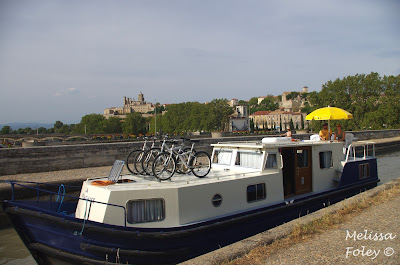The towns along the Canal du Midi are mainly small, quiet villages that sprung up after the canal was constructed. Others located near the canal have been there for thousands of years. Here are a few of our favorites.
Béziers, the southwestern-most point we ventured to on the canal, was settled around 575 BC. Like many towns built by the Romans, the old part of the city sits on a hill, providing the best defense against intruders. We rode our bikes the few miles from the canal to the old town to see the sites.
the central square in Béziers
(they have a summer bull fighting festival)
colorful street covering through the old town
bridge across the gorge leading to Minerve
(only residents are allowed to drive across)
(only residents are allowed to drive across)
town hall
walls of the city above the gorge
Our most anticipated medieval village came near the end of our trip - Caracassonne. This was a long awaited destination for the history, as well as the opportunity to check off Pete’s main travel goal by purchasing the board game Carcassonne in Carcassonne. Sadly, all the shops were sold out and the game maker had stopped printing the original version. We did have the digital version of the game, so we did get to play Carcassonne in Carcassonne but Pete was disappointed. We had a very sad story to tell our local game shop when we returned home.
The fortified part of Carcassonne was built by the Romans around 100 BC, but the area has been occupied since Neolithic times, around 3500 BC. The fortress was really impressive and the defense structures were interesting to learn about. Barbicans, murder holes, and hoardings, oh my! We got to see the city at night and during the day, which provided us really different views of the city. We also got to walk the fortress walls. Much of the city was restored in the mid-1800s, but there were parts of the original Roman walls that we could see from the new walls.
the fortified city of Carcassonne
one of the entrances to the city
Roman tower along the wall. The towers were mainly used
as defensive posts, but one was also used as a torture
chamber during the Catholic Inquisition in the
1200s to rid France of heretics, mainly the Cathars.
as defensive posts, but one was also used as a torture
chamber during the Catholic Inquisition in the
1200s to rid France of heretics, mainly the Cathars.
To get into the inner city (the keep), you had to get through two more
walls. If intruders got through this first rounded wall, they found
themselves in the barbican, an open space that would soon be filled
with arrows flying from the archers's posts surrounding the area.
walls. If intruders got through this first rounded wall, they found
themselves in the barbican, an open space that would soon be filled
with arrows flying from the archers's posts surrounding the area.
If the intruders made it through the barbican, they had to cross this bridge
(originally a drawbridge) to breach the final wall of the inner city. Upon
breaking down the door, intruders would find themselves at the mercy of
whatever defenders threw down the murder hole (a hole on the second story
that opened just after the door opening) - usually spikes, and rocks.
(originally a drawbridge) to breach the final wall of the inner city. Upon
breaking down the door, intruders would find themselves at the mercy of
whatever defenders threw down the murder hole (a hole on the second story
that opened just after the door opening) - usually spikes, and rocks.
The wooden structures between towers are called hoardings and could be
put in place quickly if the city came under attack. The outside of the
hoardings would sometimes be covered with animal furs that had been
soaked in water so flaming arrows could not start the hoardings on fire.
put in place quickly if the city came under attack. The outside of the
hoardings would sometimes be covered with animal furs that had been
soaked in water so flaming arrows could not start the hoardings on fire.
Stone cannon ball used to protect the outer walls
Pete practicing his archer's stance
Roman tower along the wall. These Roman towers are distinctive
because of the red brick, roof shape, and terra cotta roof tiles.
because of the red brick, roof shape, and terra cotta roof tiles.
The roof tiles from the more modern towers were made of slate.
The church within the walls was interesting because it was a mix of
Roman and Gothic styles. The blocky, unadorned section on the left in
this photo is the remnant of the Roman church and the ornate tower on
the right side of the photo is the Gothic flare. The light in the two
sections of the church were really different...much darker in the
Roman section where there were few windows.
Roman and Gothic styles. The blocky, unadorned section on the left in
this photo is the remnant of the Roman church and the ornate tower on
the right side of the photo is the Gothic flare. The light in the two
sections of the church were really different...much darker in the
Roman section where there were few windows.
We tended to tie up for the night outside towns where it was quieter and we had more of a space to ourselves. Occasionally, though, we needed to recharge the water tank and the batteries of our electronics so we stayed in towns along the canal a couple of times. The places we landed were really lovely. One of the towns was Le Somail. This town had an antique bookstore that was really fun to browse around, as well as a floating market/bakery on the canal where you could reserve your baguettes the night before (we should have done that - they sold out fast).
Pete browsing inside the antique bookshop
preorder box for bread at the floating market
floating market boat
In Ventenac en Minervois, we found a particularly picturesque place to tie up for a short stopover and visited our first wine cave, or tasting room. The Minervois region is known for rosé wines, which were great in the hot weather. The wine caves sell bottles of wine, but they also sell wine in bulk...for stupidly low prices. We paid €1.50 per liter for totally decent wine, which is nearly the price of water. And they dispensed it with a gas pump nozzle.
Le Moissaigaise looking lovely
the wine cave and wine museum
dispensing our jug of rosé
Columbiers before the festival...
...and during!
Our second festival encounter was in Villesequelande. When we tied up and biked toward the small town, we expected to find a sleepy little village. Instead, we were greeted by a medieval fair, complete with villagers in costumes, archery practice, medieval crafts, and beer in souvenir cups.
a plethora of jester slippers
We also managed to hit market day in many towns along the way. The markets were great...both from a provisioning standpoint and as a way to see the local culture. In Carcassonne, for example, market day was on Saturday and as soon as the market opened, people from the town were streaming in from every direction. The markets were also well stocked in most places with fruits and vegetables, bread of every variety, cheese, olives, cured meats, nuts...what more could we want?!
snails
so much delicious cheese!
bags of fresh spices
produce galore
bread of all shapes and sizes
sausages for days...
our typical post-market lunch
This wraps up our travels in France. Stay tuned for more travel adventures...









































































